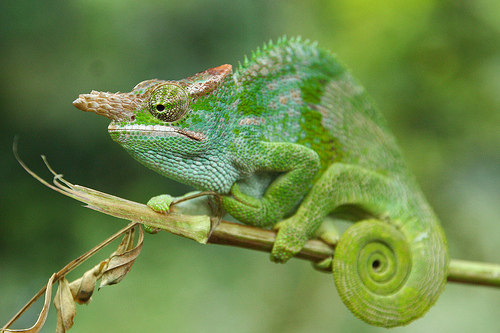Chameleons are one of a kind.
- Chameleons are a family of reptilian lizards native to Africa, southern Asia and southern Europe, and the family includes over 160 species and has the scientific name Chamaeleonidae.
- The word ‘chameleon’ is also spelt ‘chamaeleon’ and it comes from the word ‘chamaeleō’, a Latin word that in turn comes from the Greek word ‘khamailéōn’ meaning ‘ground lion’.
- Chameleons are commonly known for their profound ability to change colour, which is done by distributing the pigment cells that they have in three layers in various ways to create different colour patterns, although some species do no have this ability.
- Chameleons can range from 1.5 to 68.5 centimetres (0.6 to 27 inches) in length, and can move at speeds of 35 kilometres per hour (21 miles per hour).
- Chameleons can appear in various shades and colours of blue, green, red, orange, yellow, pink, purple, black and brown, due to their colour changing ability, and change colours for the purposes of camouflage, communicating to others of their kind, and response to environment and temperature.
Chameleon
Image courtesy of Imke.StahlmannFlickr
- Chameleons can see small objects up to 5 to 10 metres (16 to 33 feet) away, are able to see in ultra violet as well as normal light conditions, have 360° vision, and, despite lacking an eardrum and visible ear, can hear.
- Chameleons have free moving eyes, pincer-like feet, a very long darting tongue and a head with a horn or crests.
- Chameleons have a diet that mainly consists of insects, while berries, leaves and other vegetation are also consumed, although some species are believed to be more herbivorous, and for some of the larger species they consume prey like small birds and small reptiles.
- Chameleons are mostly found on trees or shrubs in rainforest, desert or savannah habitats, in their native countries, however they can been found in some areas of North America where they have been introduced.
- Depending on the species, chameleons lay egg clutch sizes of around 2 to 100 eggs in a hole they dig in the ground, and the young will hatch in four to twelve months, or up to two years in some species.
Bibliography:
Chameleon, 2013, A-Z Animals, http://a-z-animals.com/animals/chameleon/
Chameleon, 2014, Wikipedia, http://en.wikipedia.org/wiki/Chameleon







